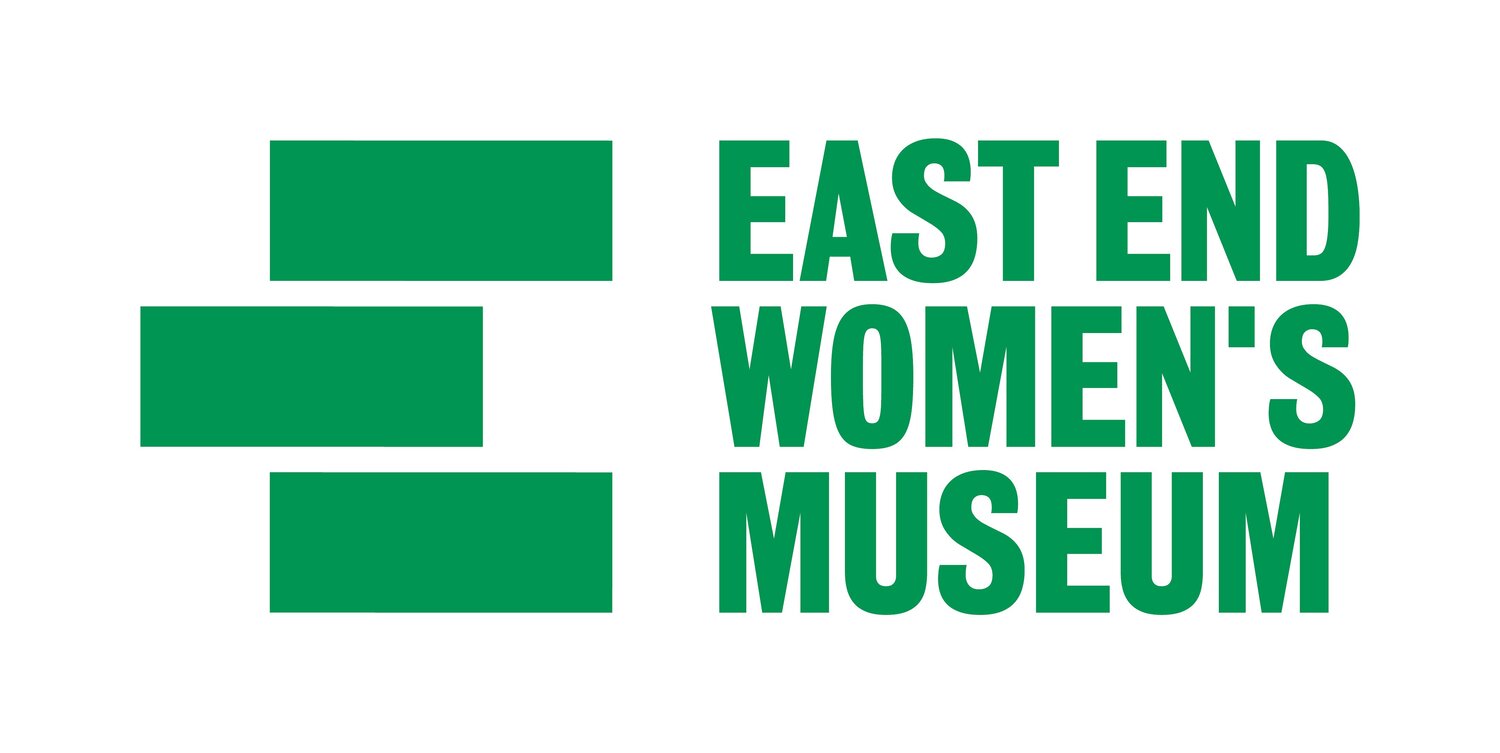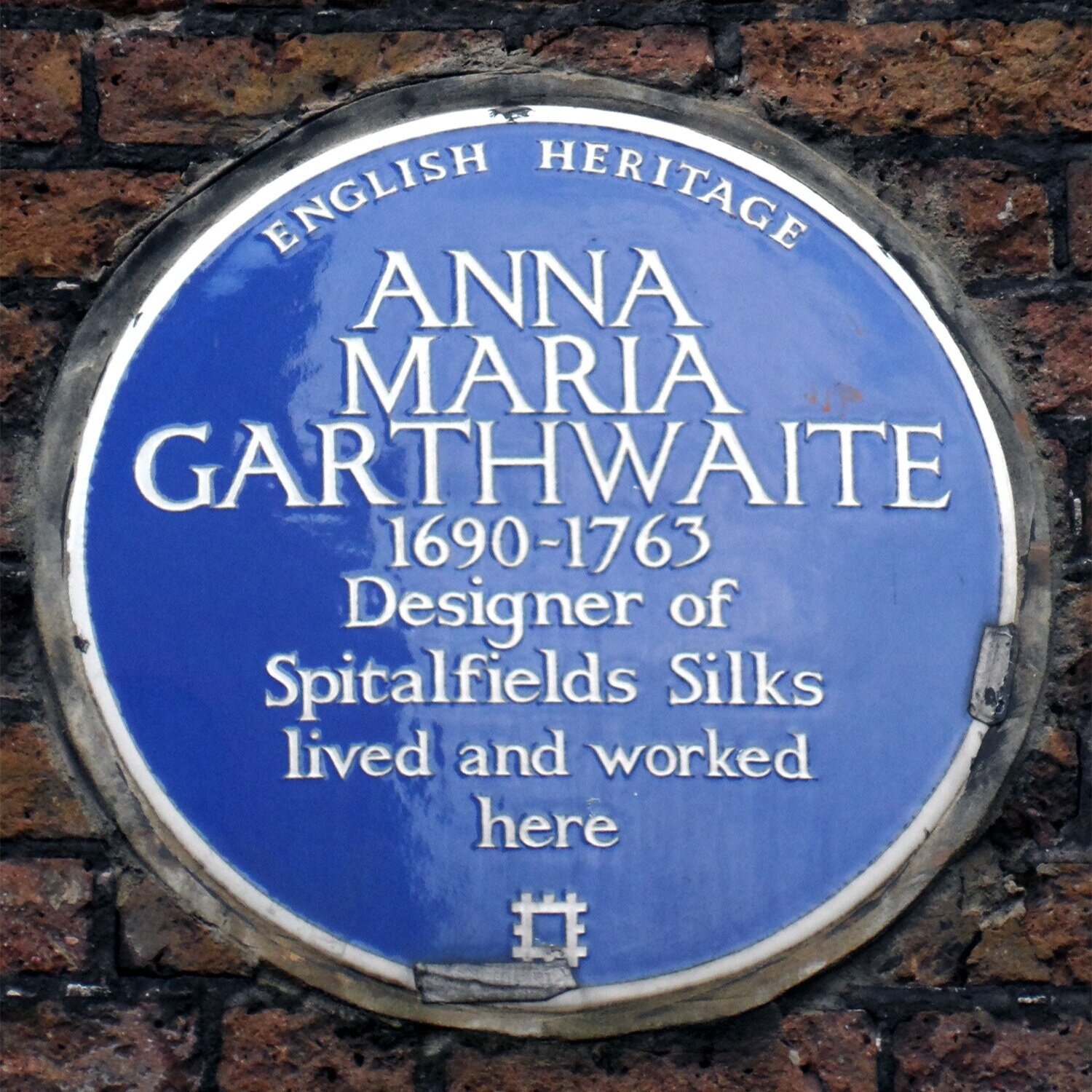We first met Anna Maria Garthwaite in this post, looking at traces of women’s lives around Spitalfields. Now, we’re excited to take a deeper dive into her story, in this piece by volunteer Janet Cleaver which takes a personal look at the textile designer and her enduring work.
I have a passion for the social history of the East End, looking into the everyday people of their time including how and where they lived. Whilst investigating the Spitalfields area I stumbled across a lady who intrigued me. Her name is Anna Maria Garthwaite. What drew me to look more carefully at this lady was the fact that in 1728 when she was in her midlife, she moved to London with her sister and set up her own successful international fashion design business in what was a mainly male dominated occupation. This business made her famous not just in Britain but across the world. Then when I discovered her work, I fell in love with it. It is not just her story that intrigues me, but also the work she produced.
Anna was born in March 1688 in Grantham, Lincolnshire. Her father was Reverend Ephrain Garthwaite and her mother was Rejoyce Garthwaite (what a fabulous name).
Incredibly, little is known of Anna’s upbringing or her life in general, but it is assumed she was well educated and born into a wealthy family. She moved to the Spitalfields area of London in 1728 with her sister, where she purchased and lived at number 2 Princes Street now Princelet Street. If you are in the area there is a Blue English Heritage plaque on the house which served as her home and workshop. The house looks pretty much as it would have done when Anna lived there.
Blue plaque denoting Anna Maria Garthwaite’s house in Princelet Street, Spitalfields.
Spitalfields was the heart of the silk weaving trade in London, it was also home to many French Huguenot weavers who fled from religious persecution in France in the 1680s. These refugees were skilled weavers and their skills and expertise only added to the already established and thriving silk trade in London.
After moving to the area, Anna began to set herself up as silk designer. This is remarkable because not only was she in her forties, but she was unmarried which was very unusual for the time. Plus, more importantly she had not received any formal training in silk design or had the skills passed on to her from a family member or previous generation. There were many women employed in the silk trade but hardly any female designers. Anna’s designs are the only designs by a woman from the era that still survive today. So rare was it to be a female designer that she used her initials to sign her work so that buyers would not be deterred by the fact that she was a woman in a male dominated trade.
As a textile designer, Anna worked mainly in watercolour and she was renowned for her vivid floral designs. She would have sold her designs to master weavers to be made up into hand woven silk. Many of her original watercolour designs have survived and are preserved at the London Victoria and Albert Museum. On many of these items Anna added the date, the name of the weaver who bought it plus the instructions on how it should be weaved. The V&A museum also hold her ledger book which lists all her work and customers. So, whilst little documentation of her personal life remains, we can still see and learn about her work and achievements. She created thousands of designs for weavers in the three decades she worked. Her legacy is preserved through the many surviving details of her work, despite little being known about the lady herself.
In the 1700s, Spitalfields designs were evolving and moving towards more floral and horticultural in their style. These gradually became more realistic in appearance and set them apart from their French counterparts. Silk designers shared the neighbourhood with the bustling and well-established fruit and flower markets of the area. Anna would have likely seen inspiring displays of flowers and exotic fruit almost from her workshop window. Her work was heavily based on flowered woven silk with an emphasis on asymmetrical structure. Her striking designs had an almost three-dimensional pattern as she used incredibly careful shading as well as merging colours and tones that made her patterns so realistic. As well as floral patterns her work also included large scale damask patterns. I find her floral designs the most beautiful, not least because they do not appear to have dated in style. They mostly comprise of clusters of small realistic flowers in bright colours on a pale background. I believe that the reason her innovate style has become timeless stems largely from how realistic and true to life her work was.
As previously mentioned, Anna did not receive any formal training. Her brother in law, Vincent Bacon however, who also lived in Spitalfields, was an apothecary. He therefore had access to the Chelsea Physic Garden (next to the Chelsea Hospital and now open to the public). This was one of England’s greatest botanical gardens of the time and it is through her experience and involvement in visiting the Physic Garden that her detailed drawings took on their realistic and natural design. The garden had species from around the world and Anna even designed patterns that grafted two species together and combined a variety of flowers in one design. Anna’s meticulous watercolour designs of realistic flowers grew in popularity as they highlighted the growing British cultural interest with gardens at this time. It was considered high fashion to wear botanical designs that were for ever changing. As silk designs were forever evolving, socialites and the aristocracy could almost demonstrate their horticultural knowledge and fashion sense through their choice of dress. Anna’s demand was international as the clever lady’s designs also included flowers grown overseas, with a keen desire to discover and draw new species. Her work was therefore popular right across the British colonies and North America. There are surviving silk panels owned by Marth Dandridge, wife of George Washington which have been accredited to Anna Maria Garthwaite.
During this time, in Spitalfields the Huguenots and their neighbours took a great interest in flowers, birds and natural history. As the weaving community grew wealthier, they were afforded more time to indulge their curiosity in the various societies that were growing in the area. They developed a love of natural beauty and natural history but mostly it was flowers and birds that drew their attention. The weavers’ passion for flowers is sometimes seen as emblematic of the community and their work. Maybe the thought that artisans grew flowers when the labouring class did not, appealed to them as it set them apart from the poorer working class within their neighbourhood. It was also thought that if a weaver could grow flowers, he was not only setting himself apart from a common labourer he was also displaying his talents as a skilled weaver.
During this period, the East London Amateur Florist Society and the East London Horticultural Society used to hold regular meetings in a pub on Bethnal Green Road called The Salmon and Ball Tavern. The origin of the name of the pub is not certain, however it has been suggested that ‘Salmon’ is reference to Billingsgate and ‘Ball’ refers to the link with weavers and represents a ball of yarn. This historic pub is still trading today. There was also a flower market in Hares Lane which was very popular with Spitalfields weavers, which appears to have grown into the still popular and ever-growing Columbia Road Flower Market.
The exceptionally talented and forward-thinking Anna Maria Garthwaite, is certainly a self-starter even by today’s standards. It would seem she rejected the patriarchal expectations of the time to get married and have children. She moved from Lincolnshire to London and had faith in her own ability to set up her own business in what was a very male dominated trade. This business not only thrived but expanded and traded across the world. She achieved this remarkable success with no formal training, completely on her own and had the foresight to keep her designs contemporary, not only for the English market but that of the overseas market as well, with her unique designs being sought after by buyers all over the world. On top of all these achievements her work is still beautiful and relevant today. I find her story fascinating and her work beautiful. Her story is one of hope as it shows it is never too late to follow your dreams and passions.
Author
Written by Janet Cleaver. She studied history at Birkbeck University and the Bishopsgate Institute. Her interest lies in exploring London’s vibrant past - unearthing stories about the people who walked our streets before us, how they lived and the ways in which their stories influence us.
Sources and further reading
Vanora Bennett, Figures in Silk (2008)
Dan Cruikshank, Spitalfields: The History of A Nation in a Handful of Streets (2016)
Anna Maria Garthwaite, Victoria & Albert Museum - Collections.vam.ac.uk
Spitalfields Life - Spitalfieldslife.com
Anna Maria Garthwaite in the MET Collections - metmuseum.org




